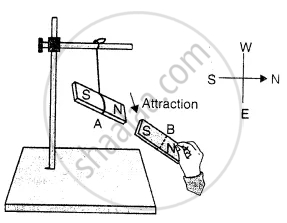Advertisements
Advertisements
प्रश्न
Describe a simple experiment to illustrate that like poles of two magnets repel each other while the unlike poles attract ?
उत्तर
Like poles repel and unlike poles attract.
Two like poles (both North poles or both South poles) repel each other. Two unlike poles (one North pole and the other South pole) attract each other. This can be demonstrated by the following simple experiment.
Take two bar magnets A and B. Suspend one magnet A with a silk thread from a support so that it is free to swing. The magnet A will come to rest in the North-South direction. The North pole of the magnet A is in the North direction and its South pole is in the South direction. Now holding the other magnet B in your hand if you bring its North pole near the North pole of the suspended magnet A as shown in figure you will observe that the two poles repel each other. Care is taken that the two magnets do not touch each other.

Now if you bring the South pole of the magnet B near the north pole of the suspended magnet A as shown in figure without touching it, you will observe that the two poles attract each other.

The above experiment shows that the like poles repels each other while the unlike poles attract each other.
APPEARS IN
संबंधित प्रश्न
Write true or false for a given statement.
A current-carrying coil, when suspended freely, can rest in any direction.
Define the following term regarding a bar magnet:
Magnetic field
When magnetic material is taken close to a magnet, the material acquires ______.
The alloys called ______ and ______ are used for making industrial magnets.
Draw lines of force surrounding a bar magnet when it is placed in the magnetic meridian with its north pole pointing geographic south.
Bar magnets are often stored in pairs as shown in the figure. E and F being pieces of metal.

What is the material of darkened part?
A magnet attracts ______.
The south pole of a bar magnet and the north pole of a U-shaped magnet will _______.
The strongest natural magnet is ______.
The magnetic poles always exist in pairs.
